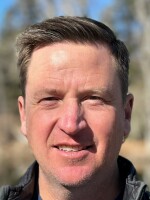DYER, Nev. – Leaving Las Vegas, where the sprawl once gave way to scrub land and Joshua trees, the desert in many places is being transformed.
New industrial scale solar farms go for miles, their neat rows of millions of panels glaring in the sun. And there are a lot more planned, such as the "Esmeralda Seven," projects near the southwest corner of the state bordering California that would provide enough power for an estimated three million homes.
"It's being pushed down our throats," says Mary Jane Zakas, who lives near the 100 square mile stretch of high desert where the seven are proposed.
Esmeralda County, population 736, is one of the most remote and poorest parts of the country. Zakas sees little benefit from the solar boom other than a few construction jobs. The power, she says, will just get exported to cities at the expense of local viewsheds and wildlife.
"Imagine, looking out your window any way and only seeing solar," Zakas says. "It's the Biden administration at the moment that has told the state of Nevada we have to comply."

The 2024 Election marked the first time Nevada has backed a Republican for president in twenty years. President-elect Donald Trump's win may in part be due to rural backlash against these new, industrial scale solar energy projects. But it's also not a given that Trump will stop or even slow the solar boom.
Biden's carbon-free pledge
The controversy in rural Nevada comes after the Biden administration's goal to get the U.S. to 100% renewable power sources by 2035. A big part of that initiative includes the Department of Interior's new Western Solar Plan. It's on track to be finalized in the coming weeks and could possibly open up tens of millions more acres of federal land across eleven western states.
Almost a third of the plan involves Nevada, which is roughly 85% federal land. But it's also remote, sparsely populated and often sunny. Federal land managers say their plan identifies the least disruptive locations that are near transmission lines or new planned transmission corridors.
But in rural Nevada, mistrust of federal agencies goes back generations. It's been estimated that close to half of Esmeralda County could be open to new solar development under the plan. Mark Hartman, a farmer near the tiny town of Dyer, thinks there's been too much emphasis on green energy during the last four years.
"What we do know is that the Trump administration wants energy independence," Hartman says. "And that is through multiple means, not just solar or wind."
Whether Trump's energy policy will be "all of the above," or just "drill baby drill" is the source of tremendous speculation across the West right now.
Trump's appetite for solar in question
Ben Norris, vice president of regulatory affairs at the Solar Energy Industries Association, says many companies are expecting a similar situation to what occurred in 2017. Federal offices set up to fast track renewable energy permitting were dismantled or applications for new projects weren't seen as a priority by federal land regulators.
"We are concerned that this type of administrative slow walking could be something that the industry has to deal with again," Norris says.
But on the other hand Norris says Trump's pick to lead the Department of Interior, Doug Burgum, has a pro-green energy track record. Burgum, who's also been tapped to head a new National Energy Council, will have a lot of say over energy development on federal land. As North Dakota Governor, he set a goal of becoming carbon neutral by 2030. He also presided over a significant expansion of wind power.
"He appears to have a sensible all of the above approach to energy issues generally in his state," Norris says.
Norris generally supports the overall Western Solar Plan because it would increase the amount of federal land available to the industry by close to tenfold. Though that's still far less than what's open to oil and gas companies.
In Nevada, about a quarter of the state's electricity comes from solar. But it's forecast to soon double as its population keeps booming.
Strange bedfellows
Meanwhile, opposition to industrial scale solar isn't just coming from conservatives here. Patrick Donnelly, Great Basin director for the Center for Biological Diversity says some projects will directly threaten wildlife and important watersheds.
Donnelly doesn't think Trump will slow down all the capital that's flooding into Nevada for solar projects either.
"There are companies that want to exploit public lands for financial gain and Trump's all about that, and whether it's lithium or whether it's gold, solar or oil, they approve it," Donnelly says.
Still, some of Trump's most staunch supporters seem to have faith that he will intervene and slow down the solar boom. High rural turnout in statewide elections in Nevada can overpower more Democratic leaning Las Vegas. Esmeralda County went 82% for Trump. Mary Jane Zakas was also elected to the local county commission.
"Trump has never had limited thinking," Zakas says. "He is very good at bringing all of the net together for the best of America's needs."
Zakas says Trump will give rural people a voice again.
Copyright 2025 NPR




